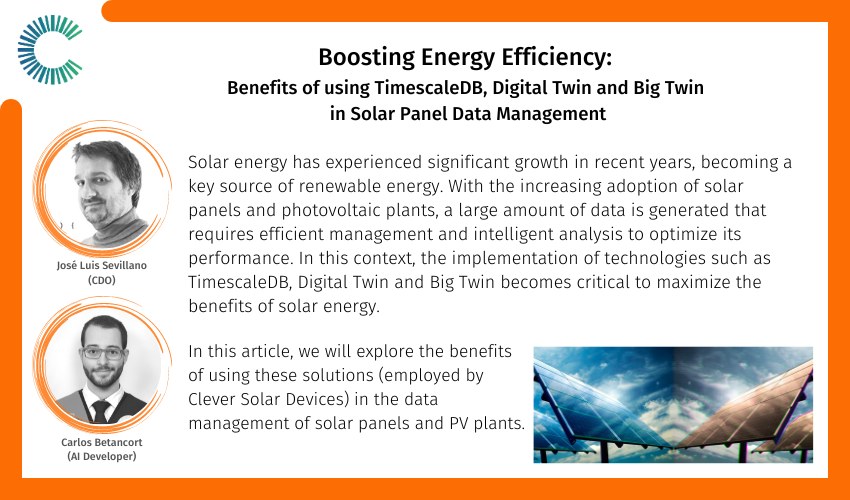Boosting Energy Efficiency: Benefits of using TimescaleDB, Digital Twin and Big Twin in Solar Panel Data Management

05.09.2023
José Luis Sevillano – CDO & Carlos Betancort - IA Developer
Solar energy has experienced significant growth in recent years, becoming a key source of renewable energy. With the increasing adoption of solar panels and photovoltaic plants, a large amount of data is generated that requires efficient management and intelligent analysis to optimize its performance. In this context, the implementation of technologies such as TimescaleDB, Digital Twin and Big Twin becomes critical to maximize the benefits of solar energy.
In this article, we will explore the benefits of using these solutions (employed by Clever Solar Devices) in the data management of solar panels and PV plants.
I. TimescaleDB: Scalability and Flexibility for Data Management
At the heart of any efficient data management system is a robust database. TimescaleDB, an open source extension of PostgreSQL, has established itself as a reliable choice for large-scale data storage and management. Its horizontal scalability allows it to handle large volumes of data generated by solar panels, while its SQL compatibility makes it easy to integrate into existing systems.
One of the main benefits of TimescaleDB is its ability to manage temporal and time series data efficiently. Data generated by solar panels, such as energy production at different time intervals, can be stored and queried quickly and effectively in TimescaleDB. This allows quick access to information, facilitating real-time monitoring and early detection of problems.
In addition, TimescaleDB offers advanced features, such as data compression and partitioning, which reduces the required storage space and improves query performance. These capabilities make TimescaleDB a powerful choice for solar panel data management.
II. Digital Twin: Real-time monitoring and optimization
The implementation of a Digital Twin, a virtual replica of solar panels or PV plants, offers significant benefits in terms of performance monitoring and optimization. By using virtual models and real-time data, it is possible to create a digital representation that accurately reflects the behavior and conditions of real solar panels.
The Digital Twin enables real-time monitoring of the solar panels, which facilitates early detection of potential failures or decreases in performance. By analyzing the data from the Digital Twin, it is possible to identify patterns and trends that indicate malfunction or the need for preventive maintenance.
In addition, the Digital Twin enables the optimization of solar panel performance. By simulating different scenarios and applying optimization algorithms, it is possible to determine the optimal configuration of the solar panels to maximize power generation. This leads to an increase in energy efficiency and a higher return on investment in solar energy.
III. Big Twin: Advanced analytics for increased energy efficiency
Big Data technology and advanced analytics play a crucial role in extracting valuable insights from solar panel data. The implementation of Big Twin, a combination of Big Data and Digital Twin, enables large-scale analysis of data generated by solar panels.
Using Big Data analytics techniques, such as distributed processing and machine learning, it is possible to identify complex patterns and perform predictive analytics. For example, it is possible to predict the future performance of solar panels based on different variables, such as solar radiation and ambient temperature. These predictions can be used to make informed decisions, such as adjusting the configuration of solar panels or planning maintenance.
In addition, Big Data analytics facilitates the identification of patterns and anomalies in solar panel data, enabling early detection of problems and the implementation of corrective measures in a timely manner. This contributes to the reduction of operating costs and overall improvement of energy efficiency.
We can conclude that efficient management of data generated by solar panels and PV plants is critical to maximize energy efficiency and optimize performance. The implementation of technologies such as TimescaleDB, Digital Twin and Big Twin offers significant benefits in terms of scalability, real time monitoring, and improved performance.
